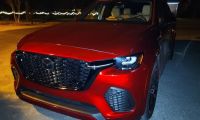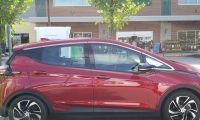Imagine yourself considering a new electrified vehicle and your top considerations were: Price, Safety, and Reliability. Which EV would you start your search with? For most buyers, the start and finish are both the Toyota Prius Prime.
The Toyota Prius Prime plug-in hybrid electric vehicle is the top-selling affordable electric vehicle in America. And it's not even a close race. The Prius Prime's 9,094 units sold through the end of April are almost 40% higher than the Chevy Bolt's. The Chevy Volt holds third place. The Leaf is a distant fourth with just 3,716 units sold in the same period. One reason the Prius Prime sells so well is that it is aggressively priced by Toyota to earn customer sales.
The base Prius Prime Plus starts at just $27,995 including destination charges. Every Prius Prime comes standard with active safety like emergency auto-braking and navigation, so there is no "stripped down" Prius Prime. Every one is well-equipped. The Premium is priced at $29,695 and the Advanced tops out at $33,995. Even at sticker prices with no discounts, the Prime is priced dramatically lower than the Volt, which starts at $34,095, and the Bolt, which starts at $37,495. However, there is a lot more to the pricing of the Prius Prime than sticker pricing.
Toyota dealers discount the Prius Prime. You don't have to take our word for it. The state of Massachusetts and other EV-friendly states have websites that show dealer discounting for the Prime. Dealers "advertise" their best prices at the Drive Green site. On the day this story was written, Prime Toyota of Boston (the dealer name is coincidental by the way) was offering $5,500 off the price of a Prime. Expressway Toyota of Boston was offering $5,353 off. After the $1,500 state EV rebate and the Federal tax deduction of $4,500, an owner taking one of these deals would pay under $19K for a mid-trim Prius Prime Premium. At these prices, a Toyota Prius Prime is less than half the price of the least expensive Tesla Model 3 sold to date. (See our pricing breakdown on the Model 3 for details).
This pricing may seem too good to be true, but Facebook Toyota Prius Prime Club member DSB (we have shortened the member's name) posted the sales sheet for the Prius Prime Advanced the member purchased this week for just $27,724 after discounts, but before state and federal incentives. After those are factored in, the owner's true cost to bu the top-trim Prius Prime is just $21,724.
Those seeking luxury, performance, or long EV-only range can certainly find it in today's American electric vehicle marketplace. However, those who make price, safety and reliability their top priorities all seem to be coming to the same conclusion on which EV is the best for them.
Related Story: Can Any EV Top The Prius Prime's Safety Scores?













Comments
The Mitsubish Mirage compact
Permalink
The Mitsubish Mirage compact car can be purchased under $13K. It has a traditional gas-powered engine with only 78 hp and 74 ft-lb torque, but to counter that low power, it weighs only around 2,000 pounds. How much do these electric vehicles weigh? The Mirage is available in 5-speed manual or CVT automatic. It has an EPA estimate as high as 37/43/39 city, highway, and combined, respectively; but drivers report up to almost 50 mpg in the real world in ideal driving scenario. It has a 10 yr; 100,000 mile power train warranty and a 5-yr, 60,000 mile bumper-to-bumper warranty. The Mitsubishi Mirage does not require any special equipment to drive it; one can pump in regular unleaded and go; it requires only slightly more than 3 qts of oil; it has a higher range than any electric; it does not have a shrinking fuel tank over time; uses a cheaper fuel, as gasoline is at most two-thirds the price of electricity on an energy basis, which is often not revealed by all the pro-electric media in a comparison supported by our governments; and it is a great example of a small foot print, reliable, cheap transportation.
The Chevy Spark and Nissan Versa are also available from $13K-$14K and have a small foot print, a little more power, a little less warranty, and not as great mpg as the Mirage but still a great value that uses little energy compared to the average American people transporter and are very small, yet highway capable for the commuter and errand runner.
Electric vehicles get a higher FE rating and certainly have some distinct advantages compared to these cheapest-of-cheap cars that can be had under $15K, but these e-vehicles are likely overrated as are most everything electric from string trimmers to semi tractors versus real world experiences, and they do not openly reveal what all has to be purchased and constructed to fuel at home. Electric everything is pretty much marketed to hide the weaknesses and exaggerate the positives to attract buyers who will be disappointed if they allow themselves to analyze these products honestly.
As an example of what happens when you buy an electric product versus gas power, I once purchased a corded lawn mower with a 21" deck that supposedly drew 13 amps. The first hidden aspect is that 100' cord necessary for mowing a decent-size lawn drawing 13 amps would require a ten-gauge cord. To buy a ten gauge cord, you'd have to build one from a cut length available at a hardware store and the plug ends sold separately for over $150. But really it turns out that you need only a 12-gauge cord, because the electric mower (which is not listed in actual power output, aka watts as it should be) did not draw anywhere near 13 amps; more like just over 9, meaning the specs were all lies. In fact, all portable cordless and corded lawn equipment and power tools do not list watts and so no one knows the actual power to compare to fossil-fueled equipment.
Moreover, back to the mower, the size was listed as "deck width"; not "cut width", which is another misleading spec that gas mower manufacturers cannot get away with, and so my 21" mower actually was a 19 3/8" cut lawn mower. The standard gas-powered mower is 21-22 inch cut width, and so the mower I purchased was being advertised as to match a gas mower on cutting width and power, but was a lie on both accounts.
I once entered a motorcycle fuel economy contest. There were electric motorcycles in the contest built by Zero Company. Those motorcycles in stock form are advertised to go over 70 miles on one charge for highway driving. However, the ones in the contest were streamlined to reduce drag, yet still could not go near that distance at a slower-than-real-world highway pace. Do you see a trend here?
Cordless tools and cordless lawn equipment are also greatly exaggerated and limitations omitted from the spec's and our regulators allow them to do so. There is also the huge issue of electric cordless equipment of all sizes and types having no standardization for batteries or chargers as if they see themselves competing against each other instead of gas equipment. I do not trust the industry at any level including automobiles to tell the truth about performance and utility and durability and serviceability, and until they are held to the same standard as traditional equipment, or they hold themselves to a higher standard for the benefit of consumers, I would not touch an electric car.
I am not against electric vehicles or any electrical equipment, as I absolutely love the idea of electric motors versus gas motors from a durability and simplicity standpoint. But consumers must have accurate and relevant information regarding price and performance and usability, battery range, and battery replacement. In today's environment, however, a person doesn't really know what he or she is actually getting with electric equipment, but with gas or diesel, he or she does; and so I'll stay in the 20th century until the electric engineers and marketers get together and decide to really compete and to tell the truth about their products.
Hi Greg, thanks for the very
Permalink
In reply to The Mitsubish Mirage compact by gregsfc (not verified)
Hi Greg, thanks for the very thoughtful comments. Some things you should be aware of. The Prius (and Volt) use regular unleaded fuel. And electricity. Owners of Prius cars report the hybrid batteries last up to 300,000 miles. And they are repairable using parts from Amazon. All plugin hybrids also have special warranty coverage on the drivetrains. 10-years or 150,000 miles in California. The Sentra is a pretty highly-rated vehicle for safety, but the Mirage and Spark are not. Both the Prime and Volt have the highest possible crash test ratings and the Prime has Superior active safety standard. Active safety is not available on the Mirage. With regards to fuel economy, almost every vehicle for sale in America has users who report "Higher mileage than the EPA." That is because they don't replicate the very conservative EPA test cycle. For example, our own editor used a Prius to go on a long trip once and he recorded 64 MPG over 800 miles of testing. You can read his account here: https://www.torquenews.com/106/guns-n-roses-road-trip-2016-toyota-prius
Thanks John. My derogatory
Permalink
Thanks John. My derogatory comments toward electrification has come about via frustration with the industries rather than biases. I'm actually a fan of electrification, but this whole bias towards them in our society: bias by gov'ts that subsidize and allow for hyped up ratings; bias by the media that don't point out the fuel cost disparity and don't point out the ridiculousness of these multiple charging systems being propagated as an entry barrier, is hindering real progress and real competition. Your examples were all with respect to hybrids. I have no interest in hybrids, because I don't believe in a two-system power train for our transportation future. I am amazed, however, with the Prius line that sort of defies my overall thinking about these products. I have never understood how Toyota was able to produce and sell a vehicle with two drive trains; two motors; two fuels and two fuel storage tanks; working in parallel, for a price just a few thousand above what this car would be with a straight ICE engine and still make a profit. What boggles my mind even more, is that Toyota is the one who has done it, because out of all the really big auto manufacturers, they seem to have the least engineering prowess for innovation; at least with advanced power trains. For instance, they had to get Tesla to help them out with further electrification beyond their parallel hybrid system, whereas GM is all about in-house production of full electric vehicles that compete right with Tesla at lower prices; yet somehow Toyota came out with this amazing parallel hybrid system for the line of Prius vehicles and somehow turns a profit where no one else seems to be able to do it and it seems like Toyota can't even replicate it in other products.
As for reliability, the Nissan Sentra (although technically in the same class as Mirage) is what most of us think of as a compact car with a higher compact price; whereas the Spark, Mirage, Versa are super-cheap subcompacts. No subcompact gets a good rating except for the Fit; and some get okay ratings but sort of straddle the line between subcompact and compact, especially with respect to price. The Sonic and the Fiesta (both being axed in North America) are slightly smaller than the true compacts (Cruze and Focus, respectively) and have only a slightly smaller price tag. So if one wants a really inexpensive new or slightly used car; there are really only four: Mirage, Spark, Versa, and Fiat 500; and all of those score poorly, and one of the main reasons they all score poorly is based on performance, i.e. 0-60 and handling and resale value. As for reliability scores specifically, I once drank that Kool-Aid as well until I started looking at what specifically drives down reliability scores, and when you see that, sometimes, it is silly little things, like the hands-free system or the navigation system (features that aren't even in the standard versions of these cars) that drive down the scores, and when you see that a lot of other silly things drive down reliability when it's not even related to automotive components; and when you see that a company like Mitsubishi who barely survives in this market doesn't have a chance for a good rating no matter how good of a car they manufacture, because the don't pay up; then you realize that some cars are really good cars and just get a bad rap. Alot of folks in the industry, for instance, won't allow a car that gets 78 hp to get a good rating. If you look further, and go to consumer ratings, such as what can be found at KBB, very few cars get a better rating than the Mitsubishi Mirage.